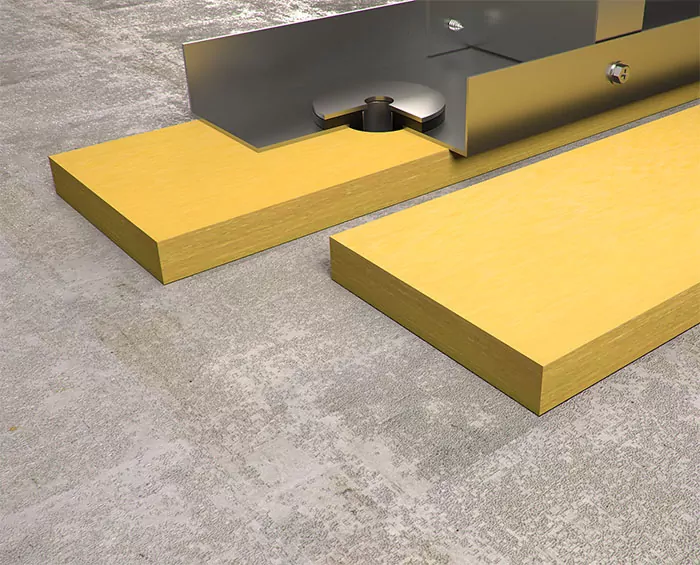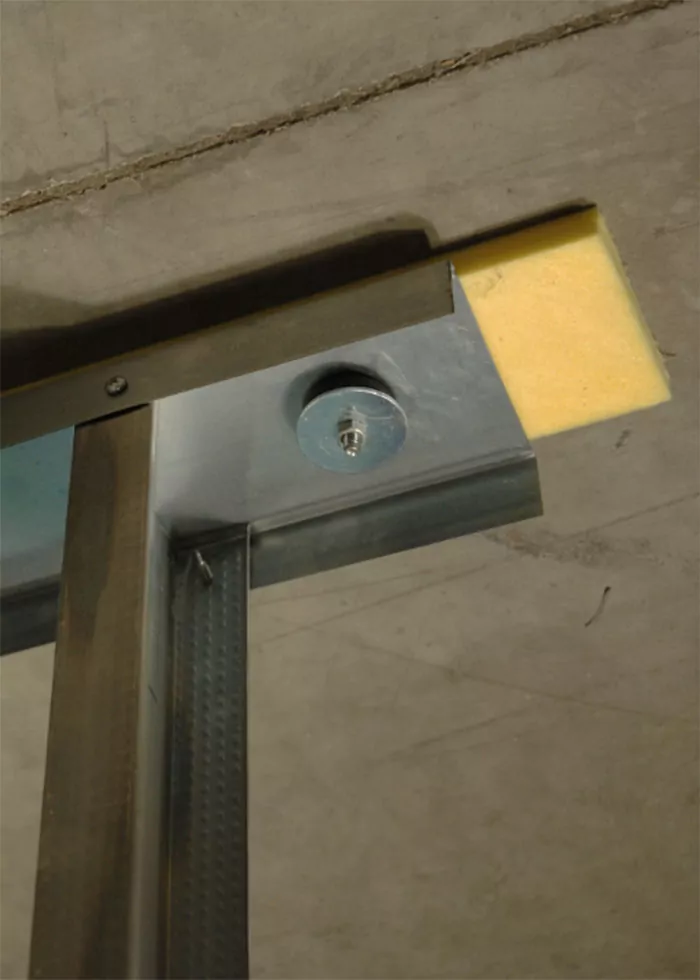



Wallmat
Stud Wall Isolator Pad & Bushings
Overview
A sound-rated floor or ceiling assembly is only effective if flanking paths are addressed. Kinetics Wallmat provides an isolated connection between the partition track and the structure, reducing flanking via wall assemblies.
Wallmat is a resilient partition isolation pad composed of molded fiberglass board that is installed above and below wall framing to decouple wall or sound-rated partitions and prevent sound and vibration from transferring to the non-isolated floor or ceiling structure.
The assembly includes a 1/2″ load-bearing fiberglass continuous isolation strip installed between the partition track and the structure and neoprene anchor bushings to isolate the anchors fastening the track to the structure. The anchor bushings also include a carbon-steel tube to prevent over compression of the fiberglass isolator and provide a solid stop for the anchor.
The Kinetics Wallmat’s standard sizing is 4′ long and 1/2″ thick. The boards are available in standard 3″ or 5″ widths – custom widths are also available. It is easily cut in the field with a utility knife.
The KAI bushings can accommodate either wood or steel studs and 1/4″ diameter or 3/8″ diameter anchors.
FAQs
How does Wallmat work?
Wallmat works by decoupling the wall framing from the floor or ceiling structure so there is no rigid connection between the two. It consists of a resilient material that is installed between the wall studs and structure, creating a separation that helps minimize the transmission of sound. Model KAI bushings are used wherever framing anchors are required to keep the anchors from rigidly contacting the wall framing.
What types of spaces benefit from the use of Wallmat?
Wallmat is often used when there is a concern about sound transmitting through the wall into the ceiling or floor structure. In many cases, whenever there is an acoustically isolated ceiling or acoustically isolated floor, wallmat helps minimize flanking paths through the wall. Wallmat may be used in recording studios, home theaters, performing arts venues, as well as offices, residences, hotels, fitness centers, or any space where sound control is needed.
Is Wallmat used at the top or bottom of the wall?
Wallmat may be used at either the top or bottom of the wall depending on the project needs.
What are KAI Bushings?
KAI bushings consist of a rubber bushing, carbon steel insert, and fender washer. They are used where anchors are required to fasten the partition track to the structure. KAI bushings keep the anchor from rigidly contacting the framing track to limit the transfer of sound between the wall and building structure.
How often do I install anchors?
Anchor spacing is typically defined by the project’s structural engineer or local building code requirements. Wherever an anchor is required, use a Model KAI bushing to avoid rigid contact between the anchor and wall framing.
What type of anchors do I use?
The type of anchor is typically defined by the project’s structural engineer or local building code requirements. Whatever anchor is required, select the appropriate size KAI bushing to accommodate that anchor. KAI bushings are available in ¼” or 3/8” diameter for wood or steel studs.
Can Wallmat be used with fire-rated assemblies?
Yes, Wallmat can be used in UL rated wall assemblies.
How much weight can Wallmat support?
Wallmat is designed for weights up to 25 psi. For higher weight loading conditions, contact us for custom designs.
Tech Specs
Wallmat can be installed at the head or base of a wall or both. Anchor bushings are designed to accommodate 1/4″ or 3/8″ fasteners for wood or metal framing.
Refer to our Kinetics Wallmat brochure for additional technical information.
